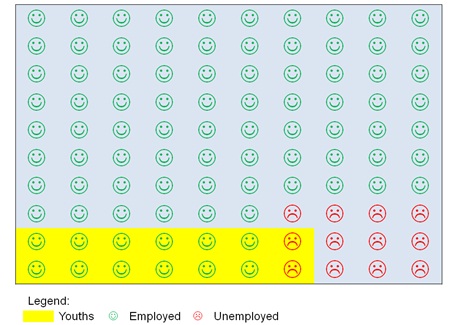Concepts and Definitions
Other than knowing the prevalence of a labour market phenomenon or practice within the labour market as a whole, one may also be interested in understanding the extent to which they occur for a subgroup, for example within an industry or a specific age group. This is where the concept of incidence comes into place.
How to compute incidence?
Suppose there were 100 persons in the labour force in a fictitious town, Astroland. 88 of them were employed and 12 were unemployed.
The incidence of unemployment, or unemployment rate, in Astroland is computed by dividing the number of unemployed by the labour force size, i.e. 12/100 x 100% = 12%.
What if we now wanted to compute the incidence of unemployment for youths in Astroland, denoted by the region shaded in yellow in the figure below?
To do so, we apply the same steps for calculating the incidence of unemployment for the whole of Astroland to the youths in Astroland.
That is,
 |
First, we compute the number of youths in Astroland’s labour force (14) |
 |
Next, we compute the number of unemployed youths in Astroland (2) |
 |
Finally, the incidence of unemployment, or unemployment rate, among youths in Astroland is 2/14 x 100% = 14.3% |
Labour Force in Astroland

More generally, the incidence figures for a subgroup within the population can be computed using the same formula for computing the incidence figures for the whole population, but restricted to the units of measure (e.g. people, companies) within that subgroup only.
Example 1 Suppose you would like to find out the incidence of unemployment, or unemployment rate, among residents aged 40 & over in Singapore.
Applying this formula for residents aged 40 & over,
Number of unemployed residents aged 40 & over in June 2010 = 35,400
Number of residents aged 40 & over in the labour force in June 2010 = 1,095,700
Hence, incidence of unemployment or unemployment rate for residents aged 40 & over
Example 2
Suppose we want to find out the prevalence of term contract employment among professionals.
Overall, the incidence of term contract employment is computed using the following formula:
/Incidence%20Concepts%20and%20Definitions%2004.PNG)
Applying this formula to the data for professionals only (for time period June 2010):
Number of resident employees in professional jobs working on term contracts = 29,500
Number of resident employees in professional jobs = 291,500
Therefore, incidence of term contract employment among resident employees in professional jobs
